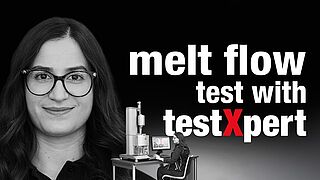ASTM D1238 and ISO 1133-1/-2: Standard-Compliant Testing Made Easy!
To determine the melt mass-flow rate (MFR) or melt volume-flow rate (MVR) of different types of polymers, you may come across a few challenges: on the one hand, it is important to know the weight and respective temperature at which the polymer is to be tested in order to be standard compliant. On the other hand, it is critical to control the volume of polymer to be added to the tester and the preheating phase of the test in order to start the measurement of the melt flow rate exactly within the specified window. However, to determine these test parameters it is usually necessary to perform preliminary tests, which can be time consuming and tie up laboratory personnel. Let us tell you how easy and efficient standard compliant testing is with the Aflow and testXpert.
For the user, the Aflow and testXpert mean: simply add five grams of material to the extrusion barrel. The test starts and you can rely on the fact that it is running according to standard and with optimal test parameters.
Laboratory managers benefit in the following way: they no longer need to rely on lists with the correct parameter settings for each polymer type. And they can rest assured that employees have performed the test correctly.
The benefits also extend to auditors: they no longer have to question how the lab ensures that every test on every polymer type is run strictly according to standard, because testXpert has taken care of it.
How does the Aflow work?
Force-controlled extrusion plastometers, such as the Aflow function similar to a capillary rheometer and have significantly expanded control capabilities. Laboratory personnel may agree to use a test sample weight of five grams for all MFR values above 1 g/10 min. In many cases, the material volume can be easily taken from a container, using the right size scoop. Right at the start of the test, the instrument detects the fill level in the barrel and measures the expected magnitude of the MVR of the polymer early in the preheating phase. Based on this ongoing available information, the instrument continuously calculates the ideal, standard-compliant trigger position from which the piston must move freely under test load to reach the target window at the start of the test. With the flow rate present just before the target window is reached, the Aflow decides at which piston travel distance the measurement must take place.
The latest version of the ASTM D1238 standard, released in February 2023, supports the use of force controlled extrusion plastometers for the determination of MFR and MVR values. The ASTM D1238 counterparts, ISO 1133-1 and ISO 1133-2, have documented the use of force-controlled extrusion plastometers for many years. In the various processing stages of the plastics industry, a number of laboratories are therefore already using the Aflow and rely on its robust design, simple operation and reliable test results.
